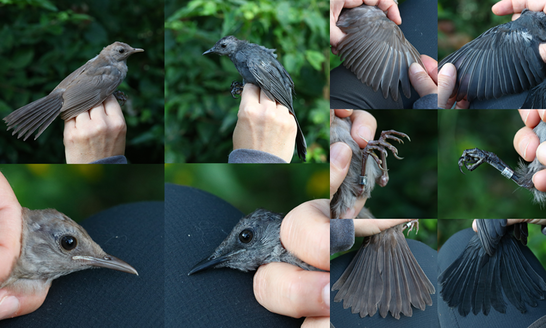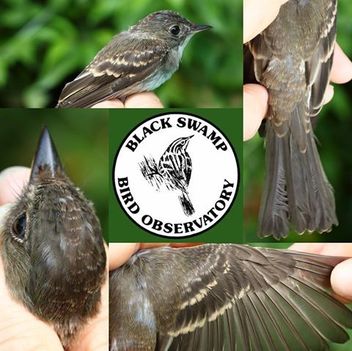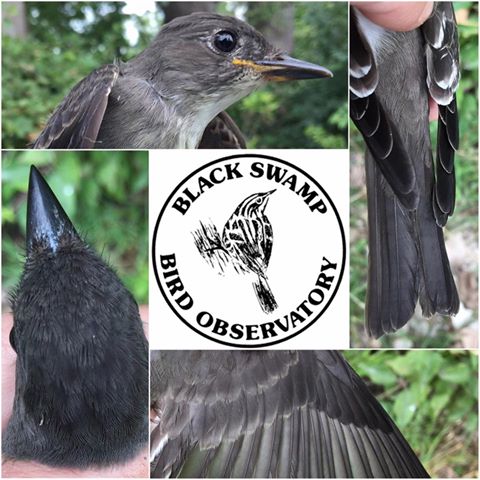Enjoying our blogs?Your support helps BSBO continue to develop and deliver educational content throughout the year.
|
|
Starting August 14th, the Navarre Marsh Banding Station has been operating nearly seven days a week, sampling migratory birds as they pass through the marshes of western Lake Erie. It’s only been a few weeks, and migration is still quite slow, but boy have we seen some great birds come through the station already! Beginning with a surprise Kentucky Warbler on the first day of banding, so far our warbler list has reached 21 species for the fall season, including Connecticut, Canada, Mourning, Blackburnian, and Chestnut-sided. Not too bad of a start for the beginning of September. Aside from warblers, in our first few weeks we’ve also begun seeing hints of other migrant families represented by Veery, Gray-cheeked Thrush, Swainson’s Thrush, Philadelphia Vireo, and Yellow-bellied Flycatcher. It may seem early in fall migration, but birds are moving, and many of the marsh’s summer breeders have already departed. Yellow Warblers are entirely absent, and Prothonotary’s have become few and far between. Staging Baltimore Orioles are drastically reducing in presence, and Gray Catbirds (abundant only a week ago) are slowly filtering out. But while others are departing, and some are trickling in, flocking species such as Common Grackle and Cedar Waxwing continue to stage along the lake shore, building in numbers every day. While every bird that passes through the station is incredible in its own way, there have been a few birds recently that really caught our attention. The first being an aberrant plumaged Gray Catbird (hatching-year, full juvenal plumage, affectionately termed the Glaucous Catbird) with an apparent melanin deficiency. While most pigment aberrations seem to affect only the feathers on the majority of birds, the interesting thing about this catbird was that every body part color was subdued. Body and flight feathers, beak, legs, and eye color were all a paler color than found on a typical individual. Photographing subtle colors can be difficult, so to try to make the pale color obvious we photographed a normal catbird of the same age shortly after the paler bird in the same lighting. Nearly a week after our first encounter, the pale cat was recaptured with slight signs of body molt. Limited mostly to the crown, the incoming feathers (which would typically be black) appeared to be coming in as a dark brown color. It’ll be interesting to see what this catbird looks like after it completes its molt. Hopefully it’ll stick around a little longer or come back in the spring to offer us a glimpse at its incoming plumage. An unusual visitor for the fall, a hatching-year Olive-sided Flycatcher stopped by this past week, exciting our team and drawing our attention to the plumage characteristics of young flycatchers. Hatching-year flycatchers are easily distinguished from adult birds by the presence of buff tipping to feathers and buff-cinnamon wing bars. This is especially true among the Empidonax flycatchers who show whiter wing bars as adults, in addition to other species who don’t show wing bars as adults, like Eastern Phoebe . For whatever reason, we don’t often see Eastern Wood-Pewees in juvenal plumage, even though it is a local breeder. But the very next day after catching the OSFL, we then caught a hatching-year EAWP, still mostly in juvenal plumage. These two species are members of the genus Contopus, so catching juveniles of each was a great way for us to focus on a new group of flycatchers other than Empids. For a bird that will eventually molt in green-gray feathers, it was interesting to see the extent of buff-tipping to the majority of juvenal body, as well as the wing covert feathers in the EAWP. These buffy wing bars in the EAWP will be white in an adult bird. Also a hatching-year (but further along in molt), the OSFL only showed the slightest edging to remaining juvenal feathers on the back, as well as distinct pale wing bars. These wingbars will be narrow or non-existent in adult OSFL. One very interesting detail we noticed on both of these birds was that the buff/pale edge of these juvenile feathers is even evident at the tips of the flight feathers and tail feathers of both of these closely related species.
0 Comments
Your comment will be posted after it is approved.
Leave a Reply. |
AuthorsRyan Jacob, Ashli Gorbet, Mark Shieldcastle ABOUT THE
|


